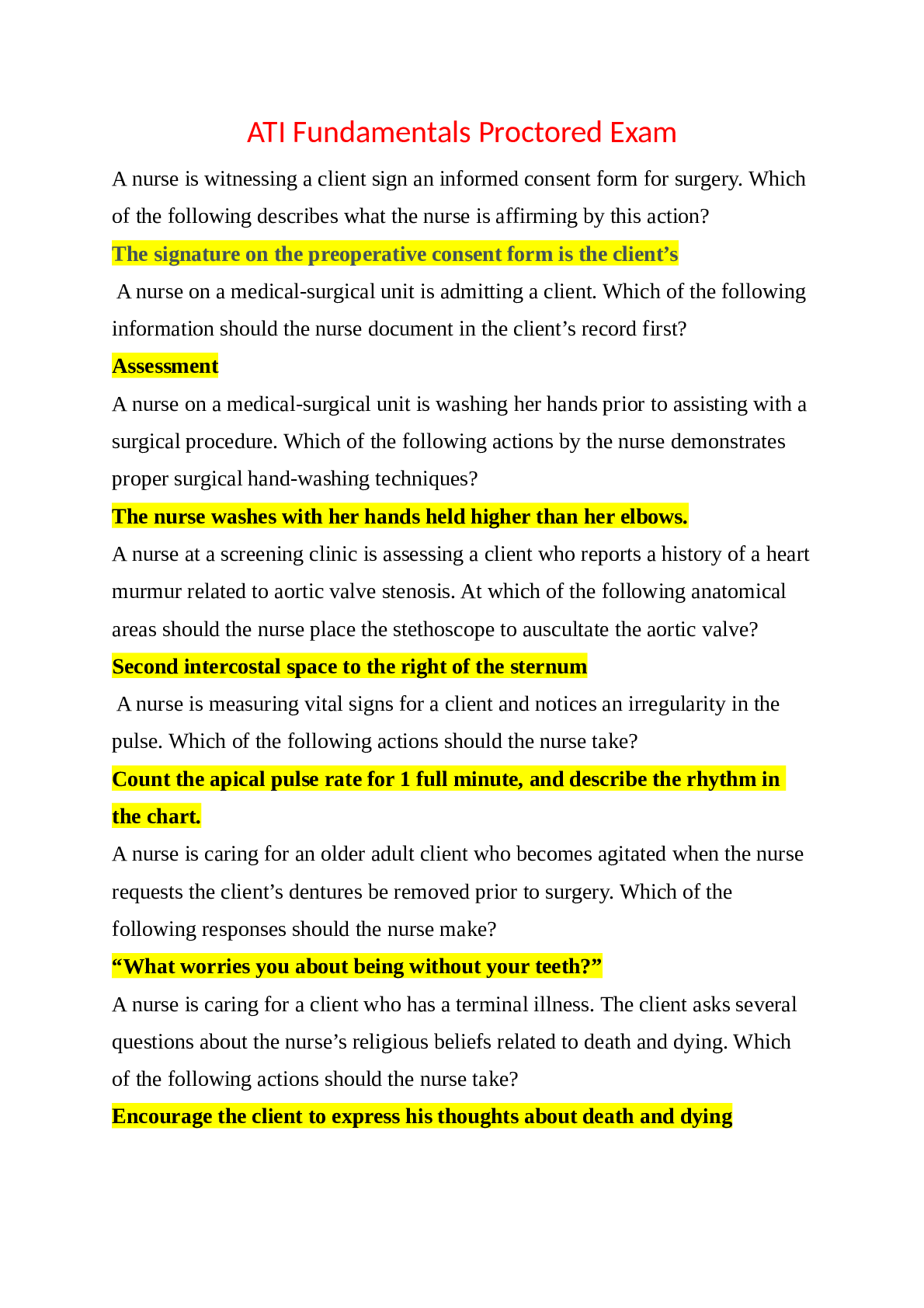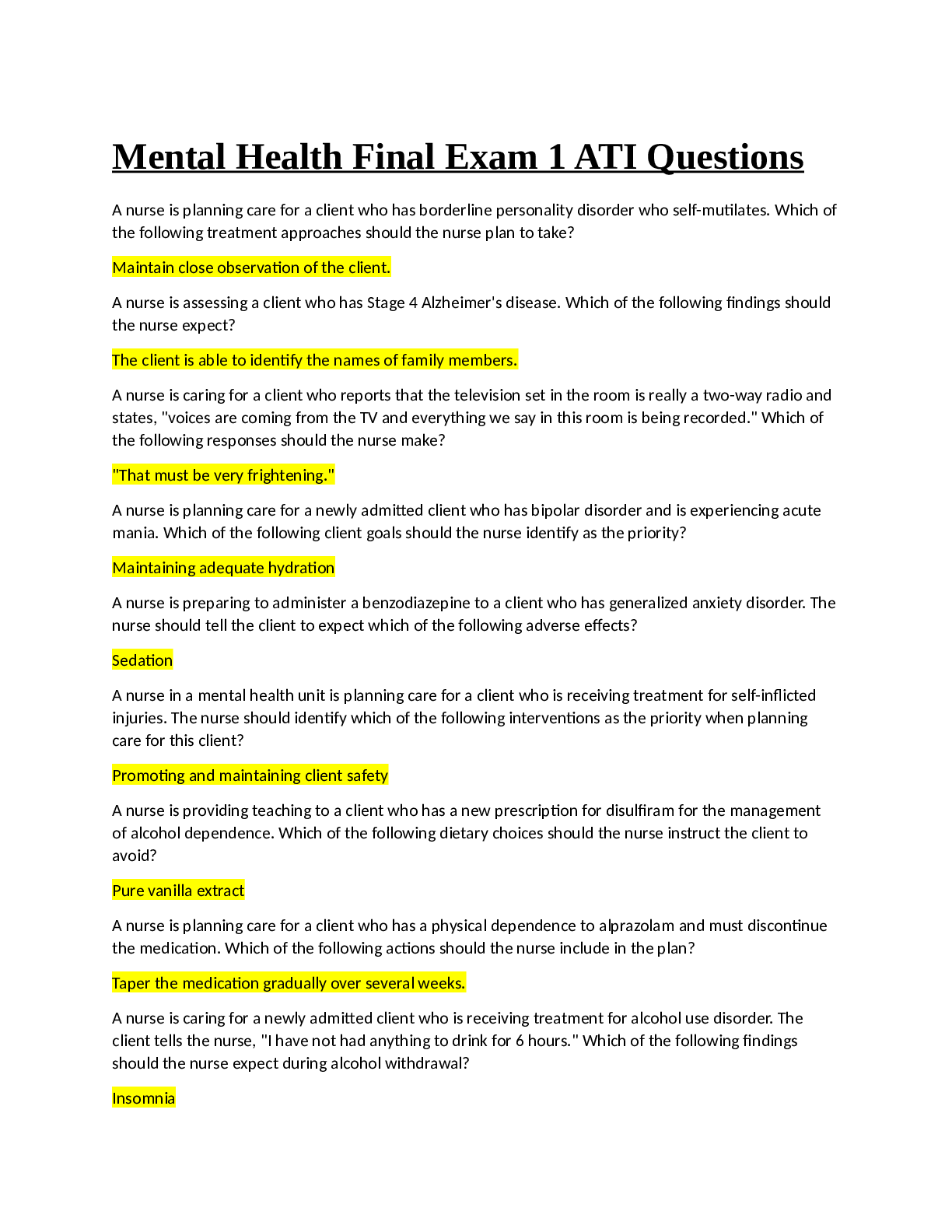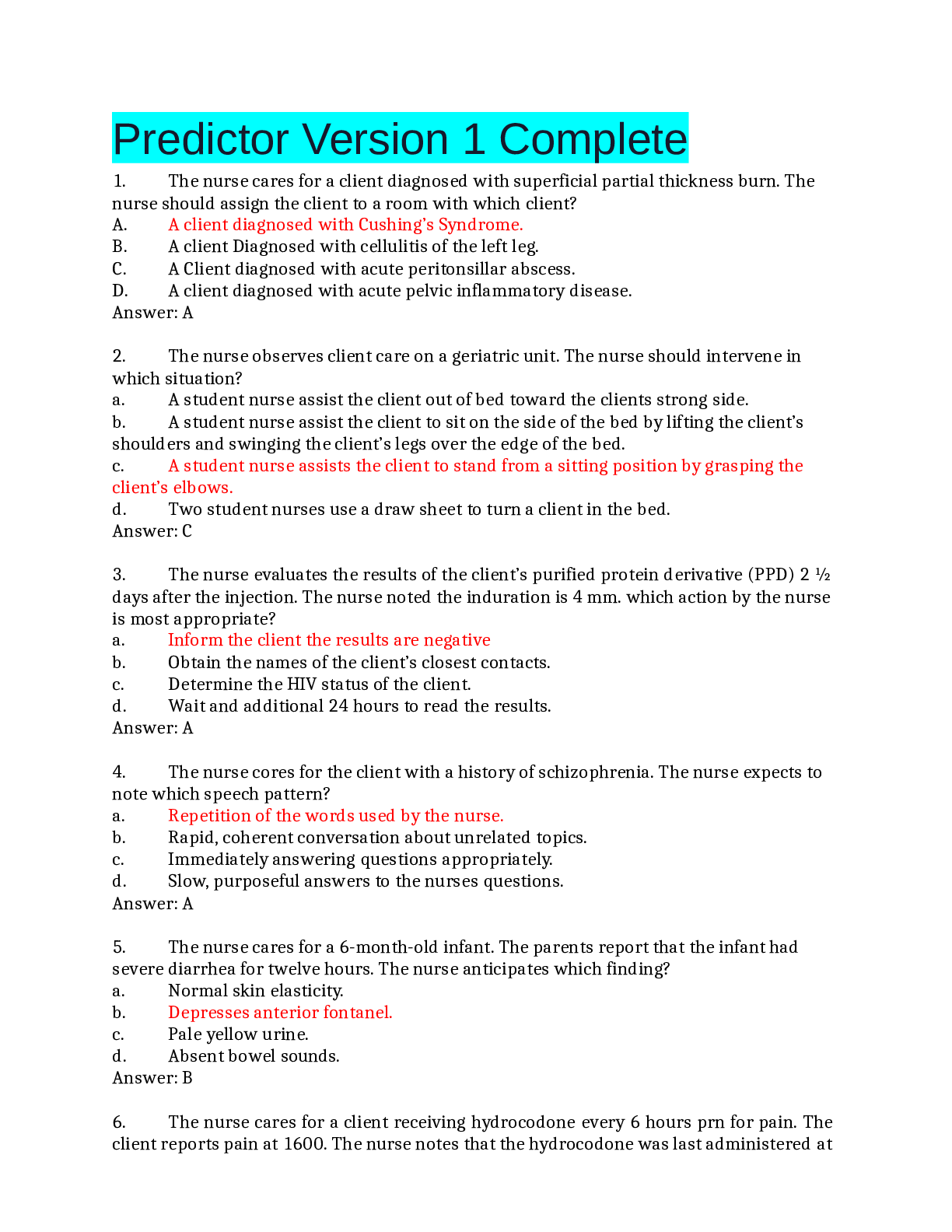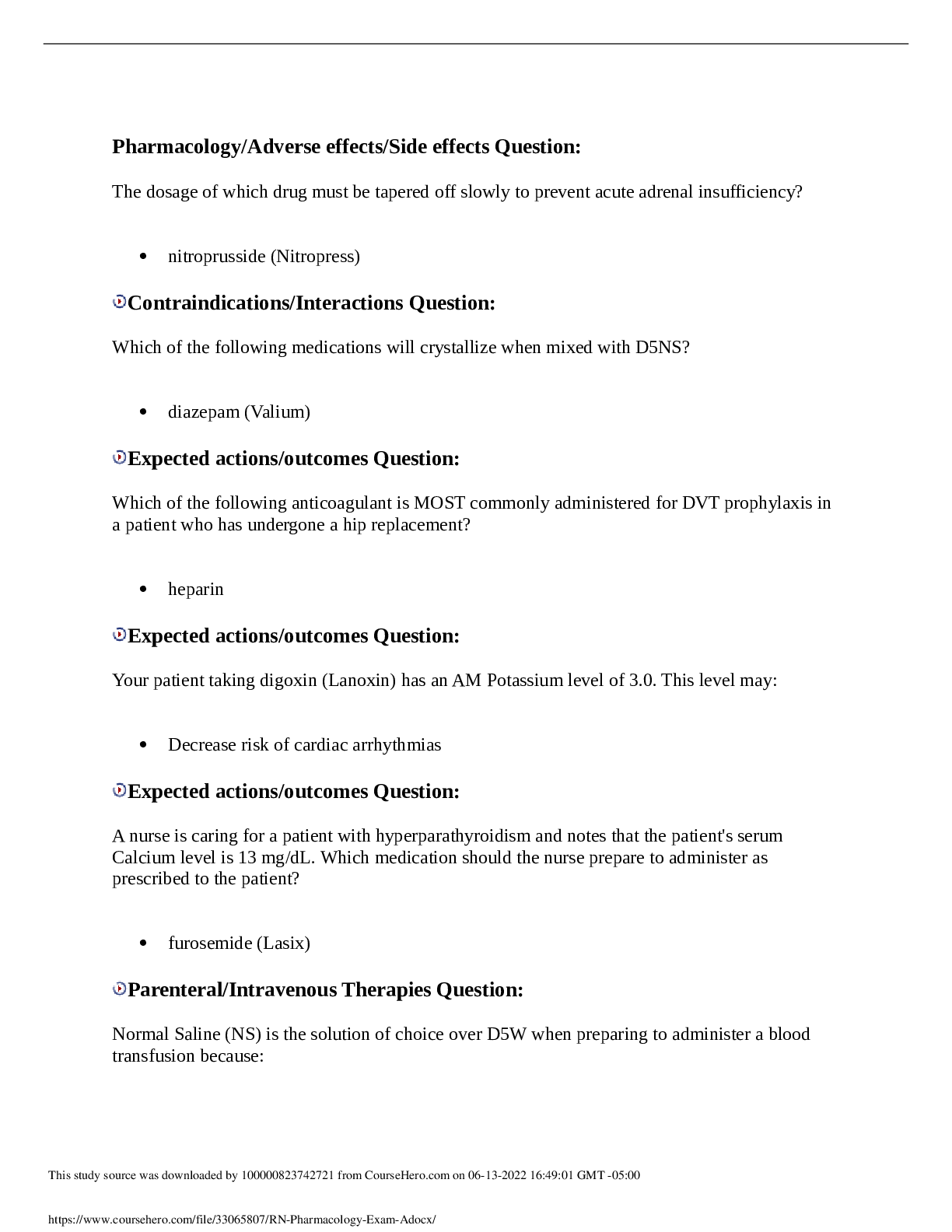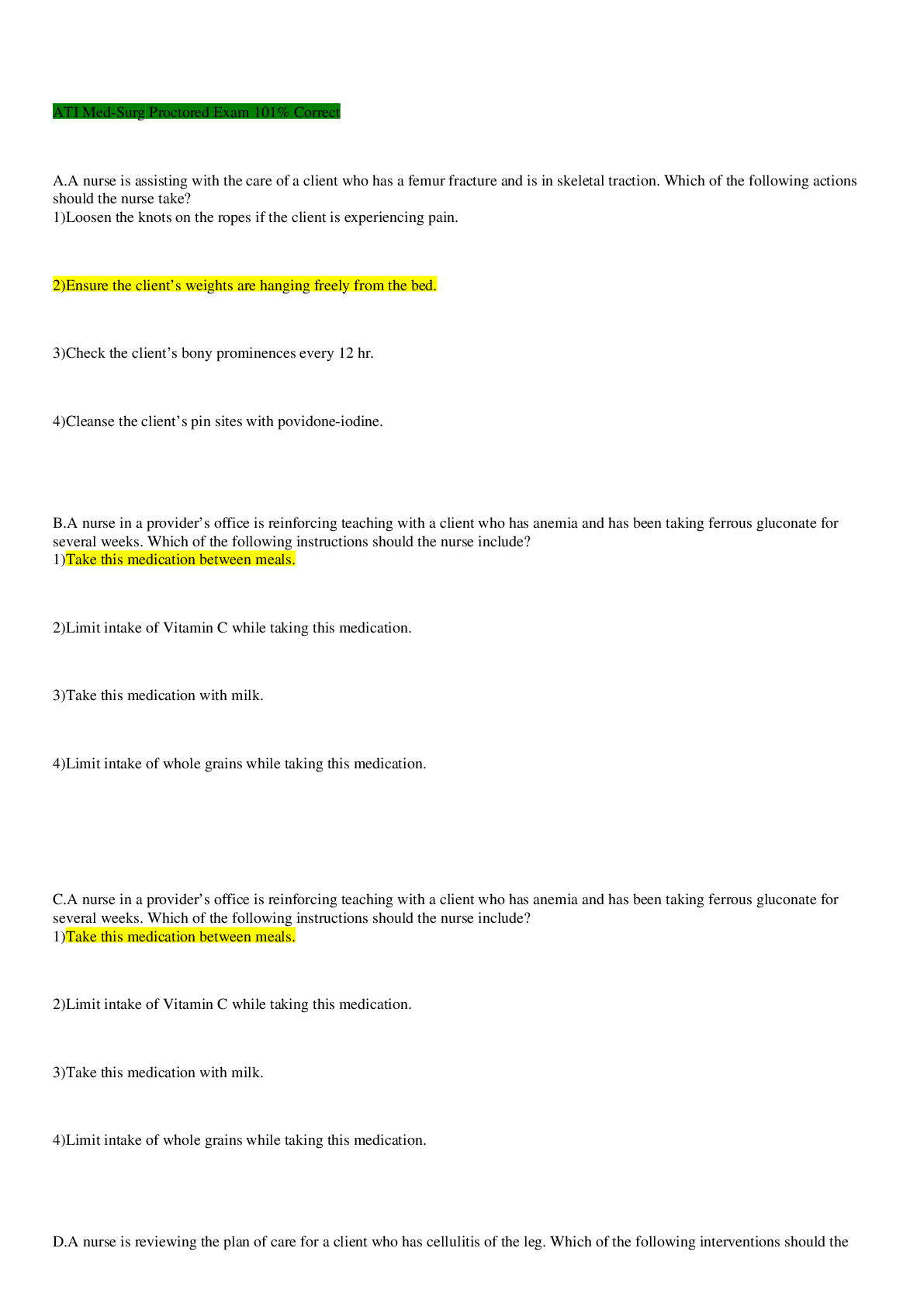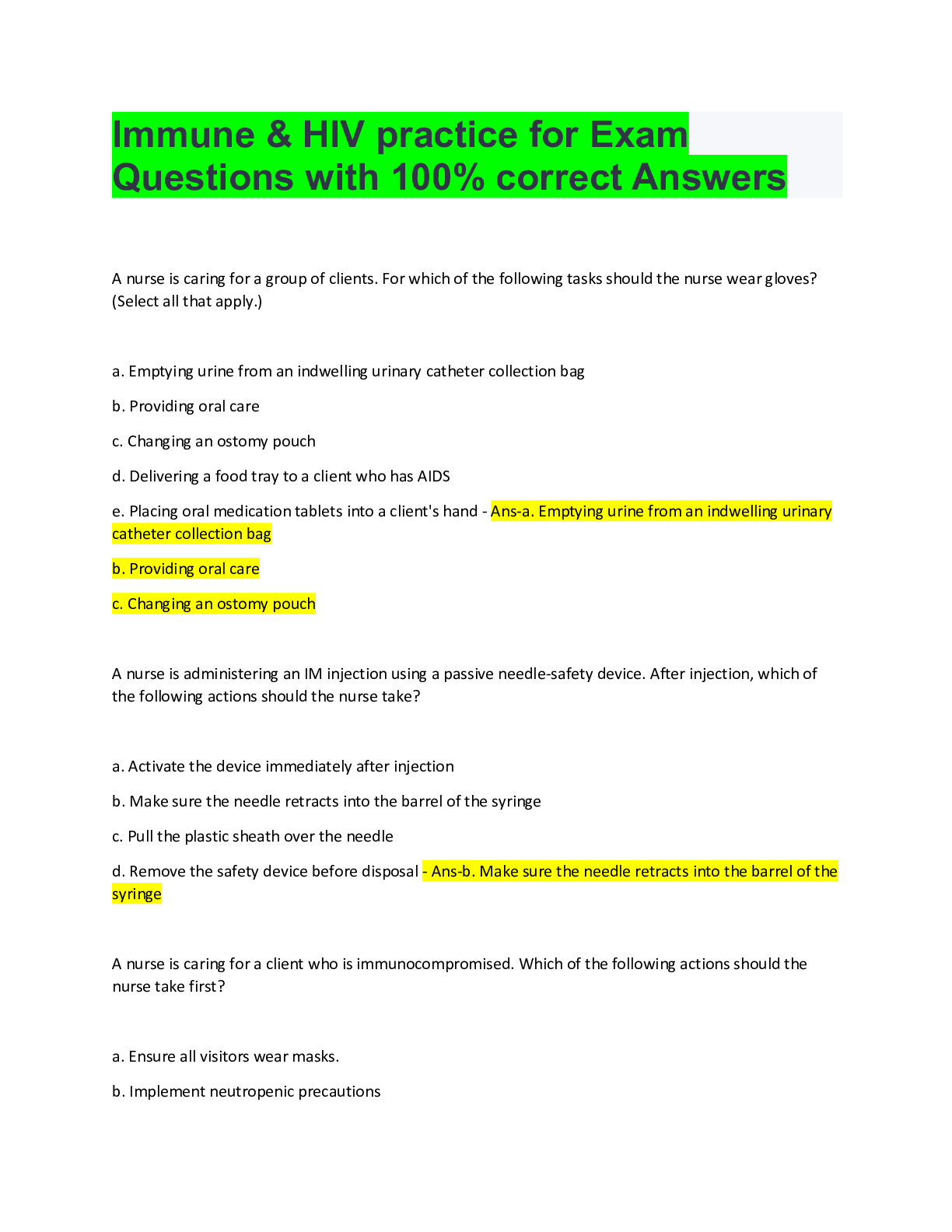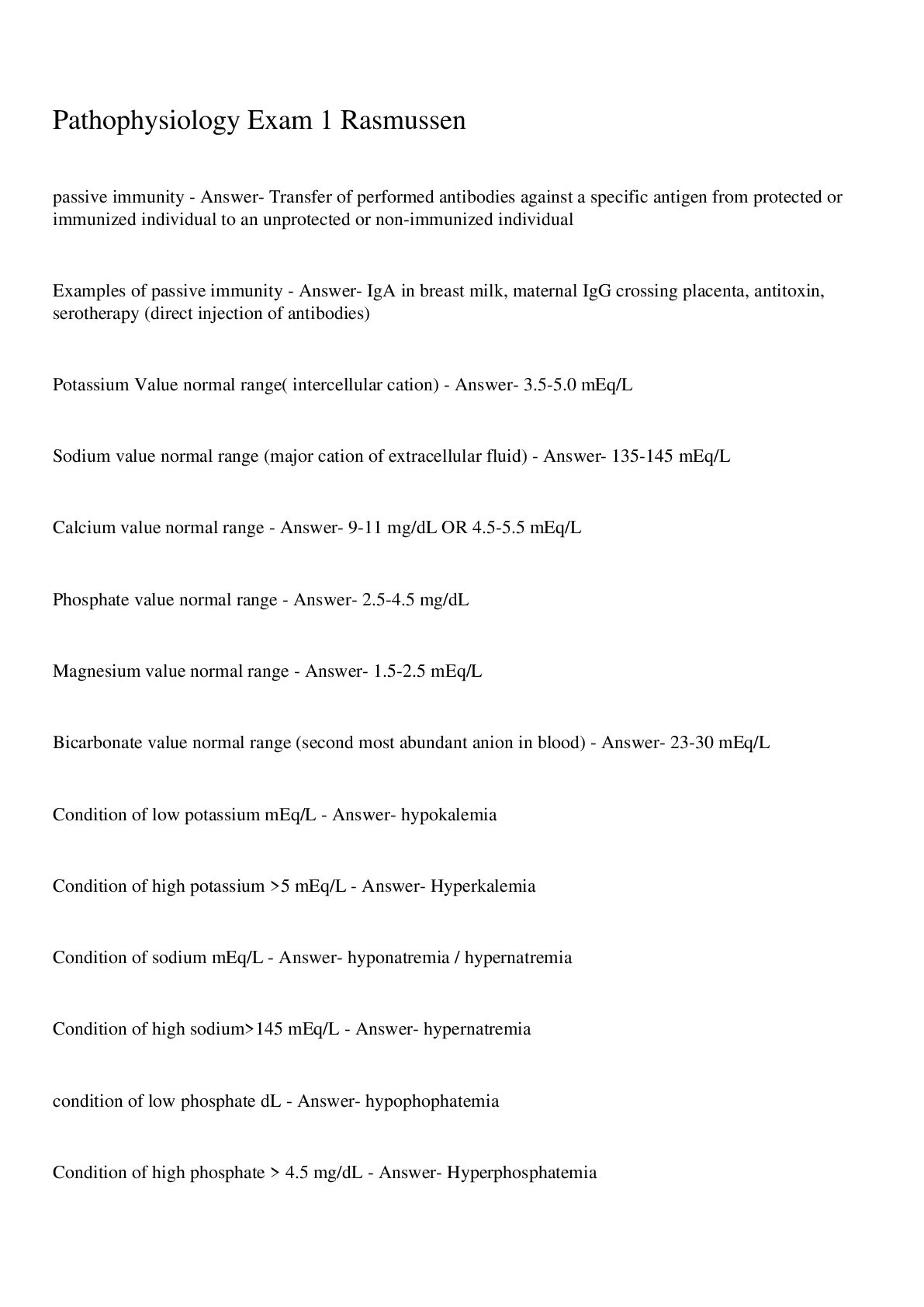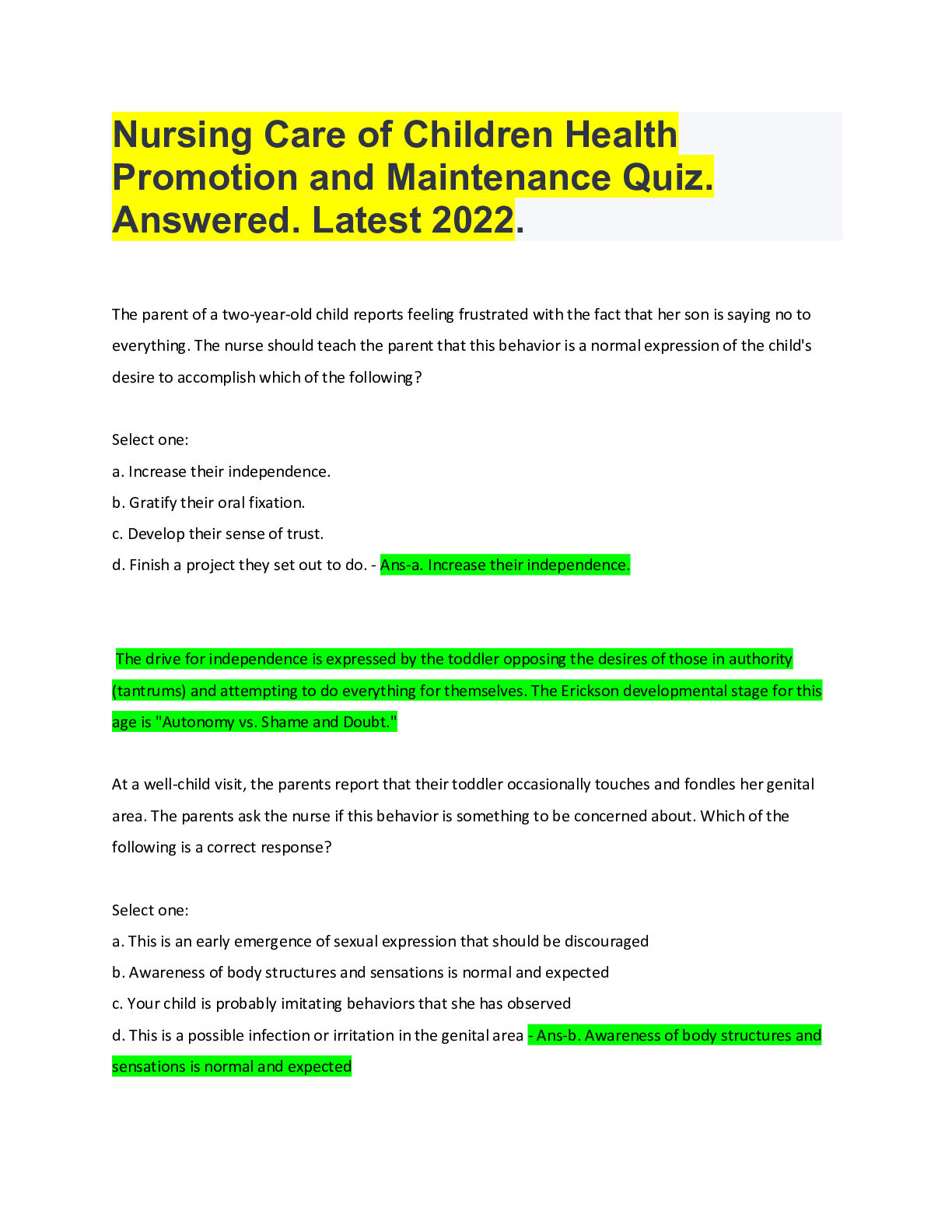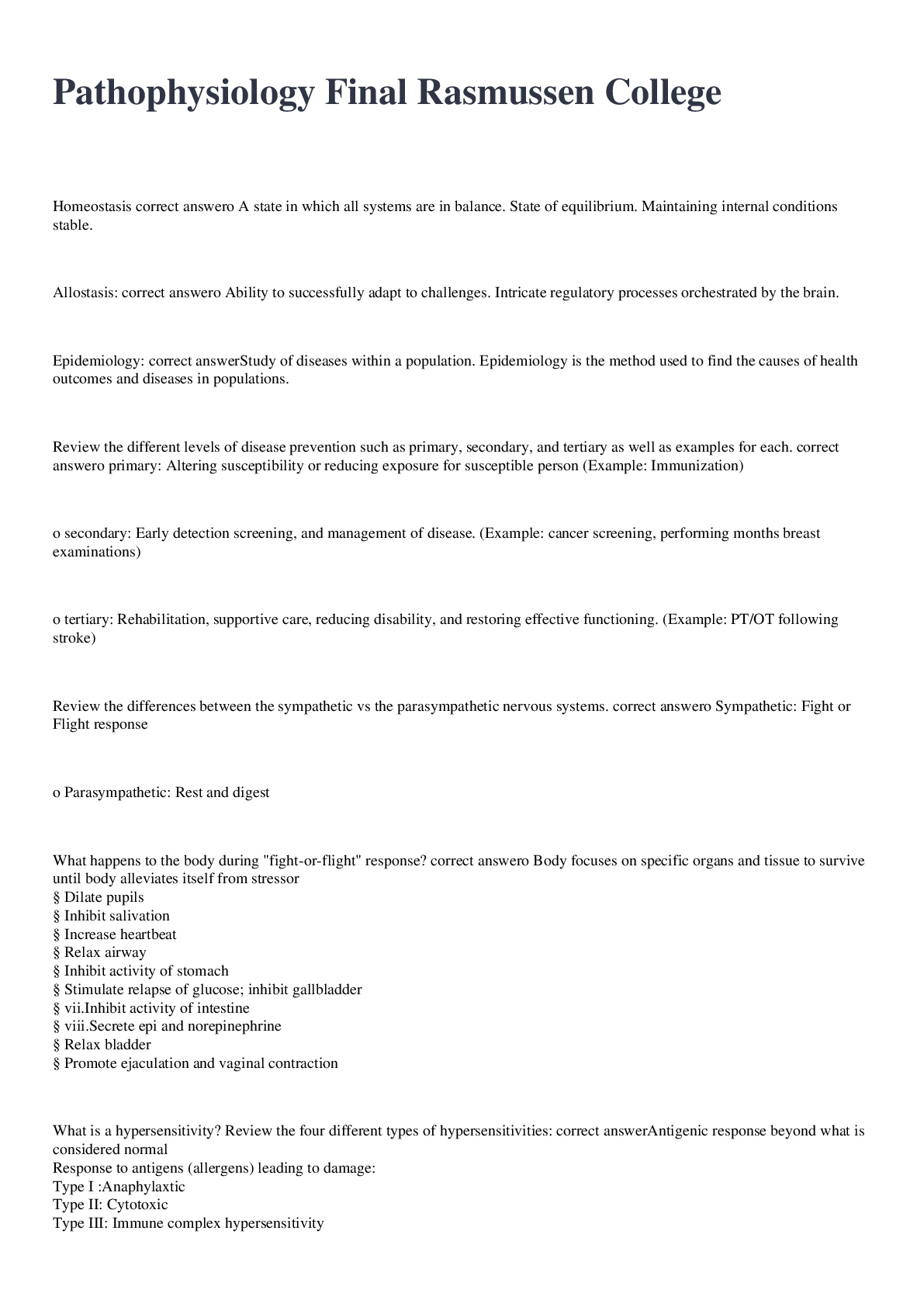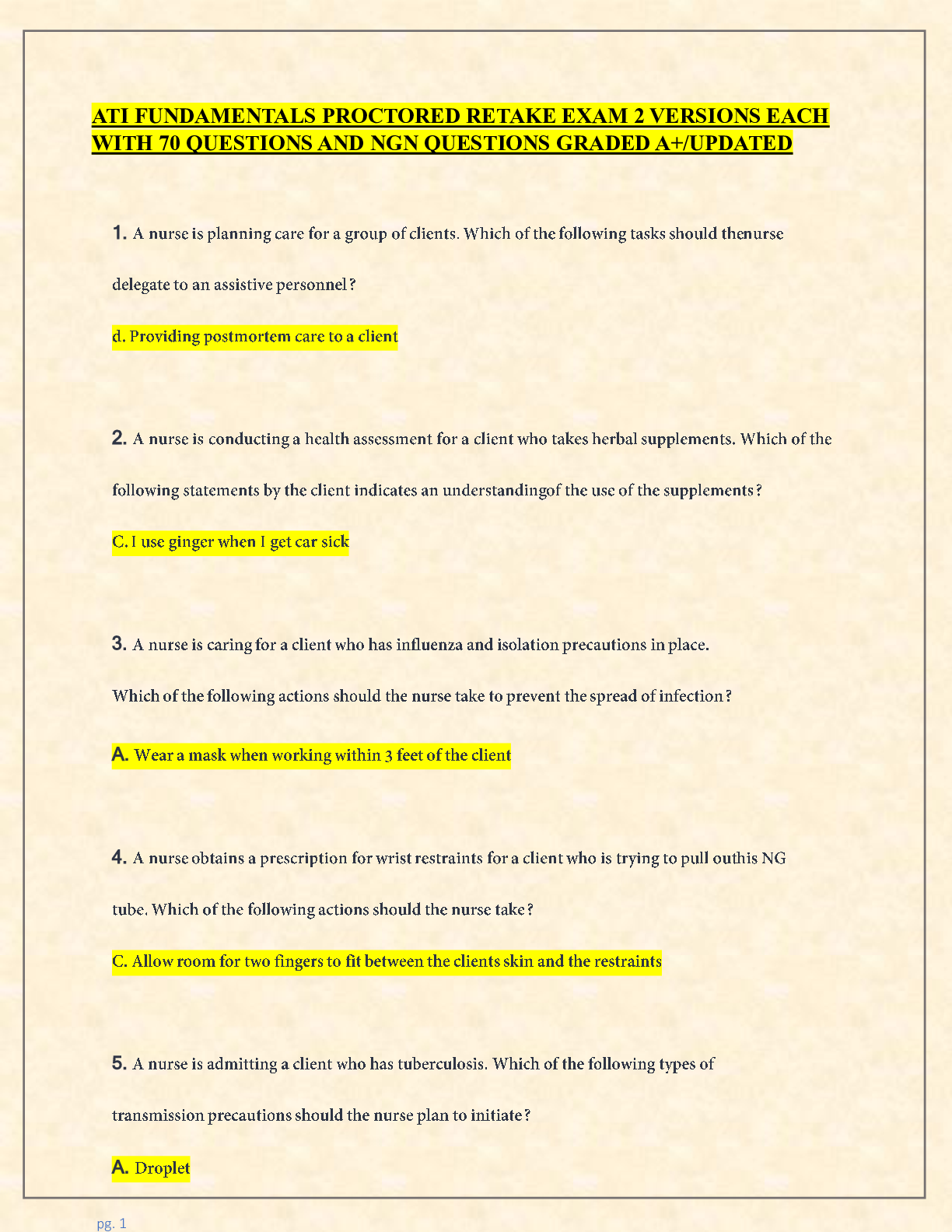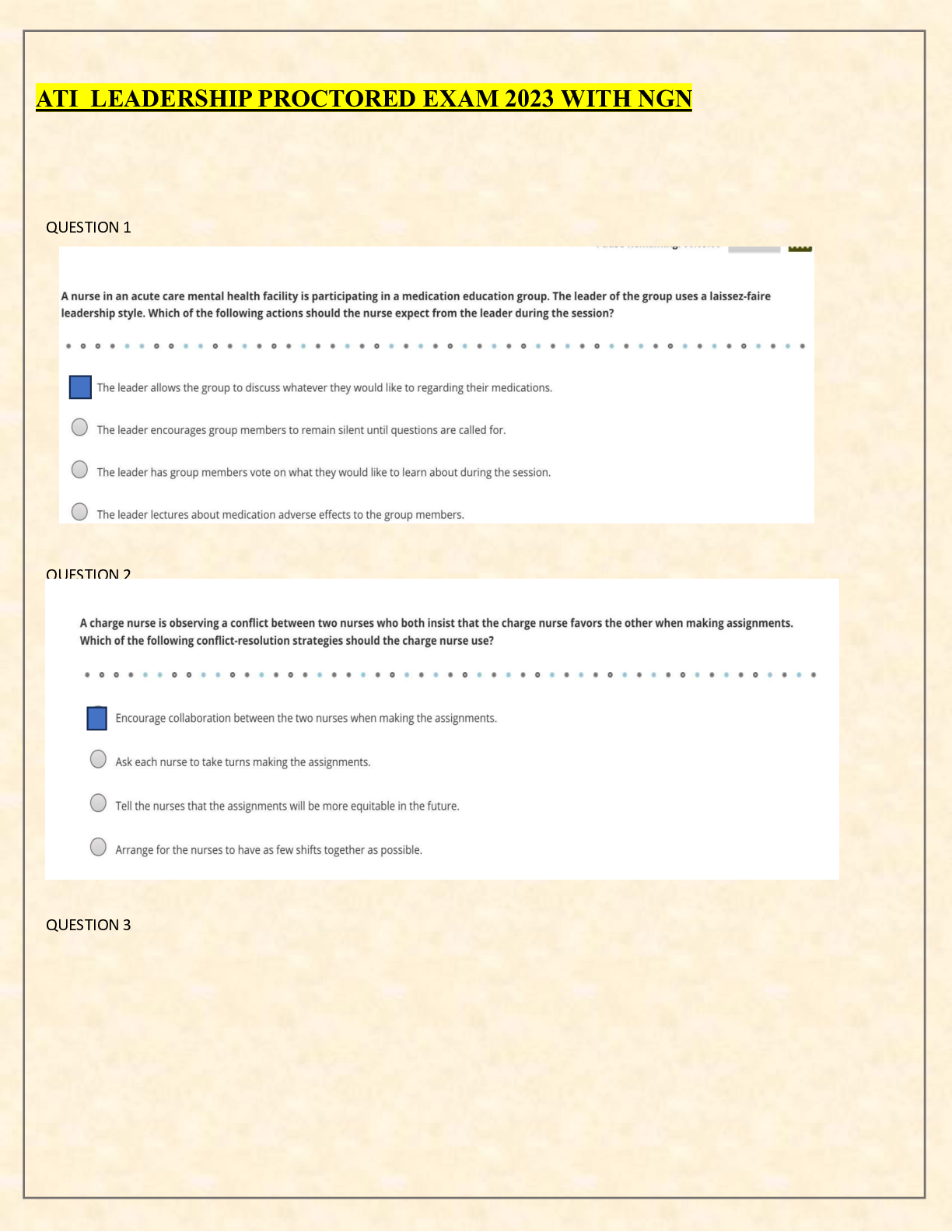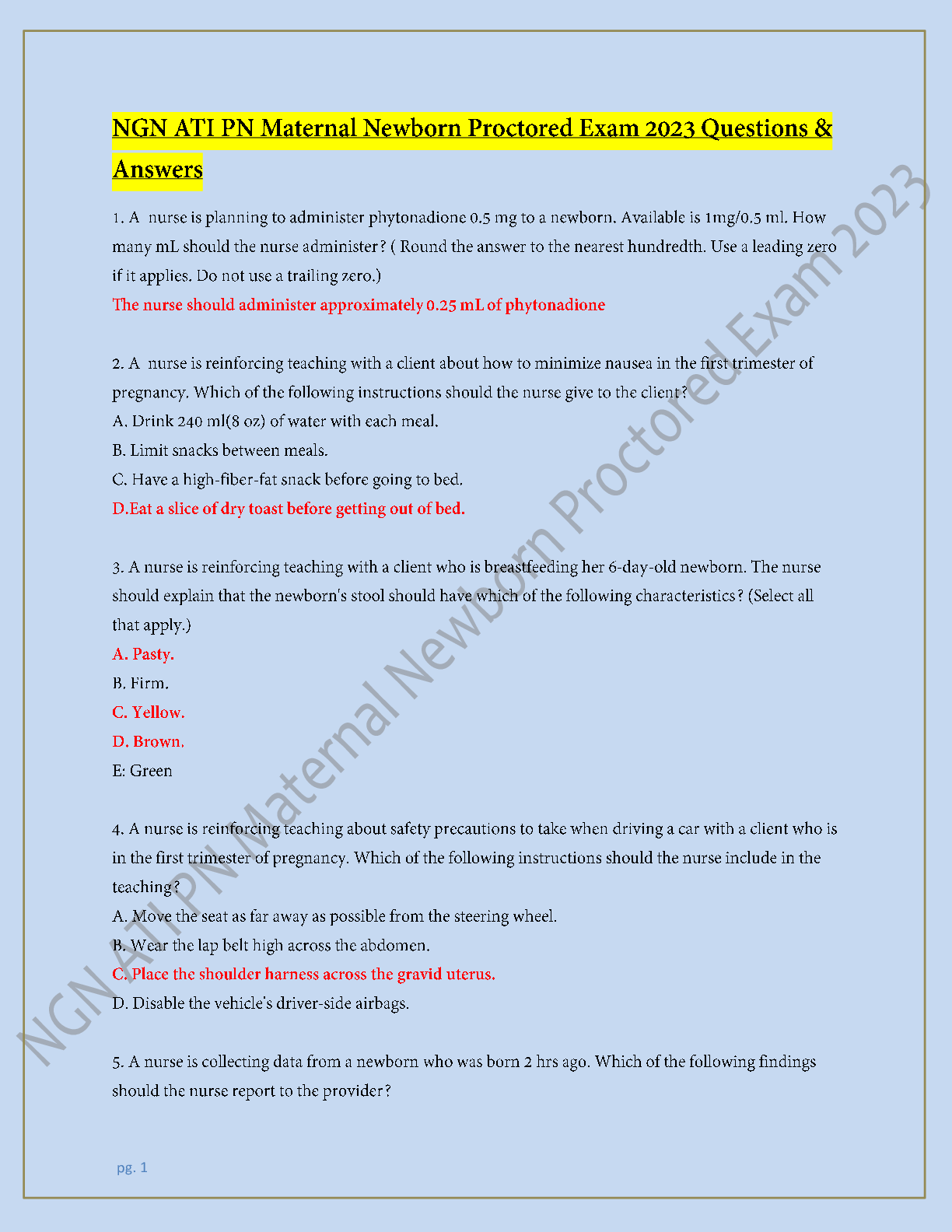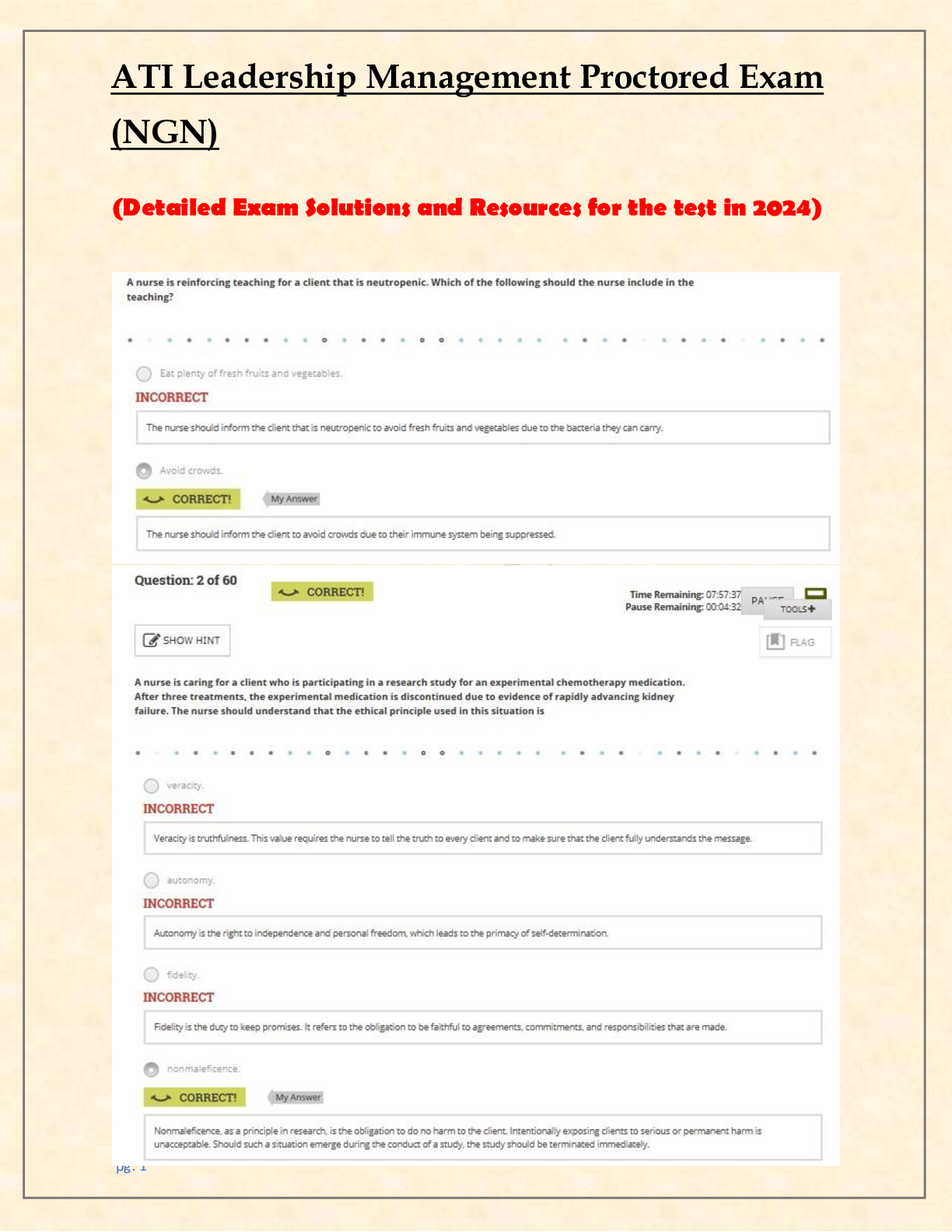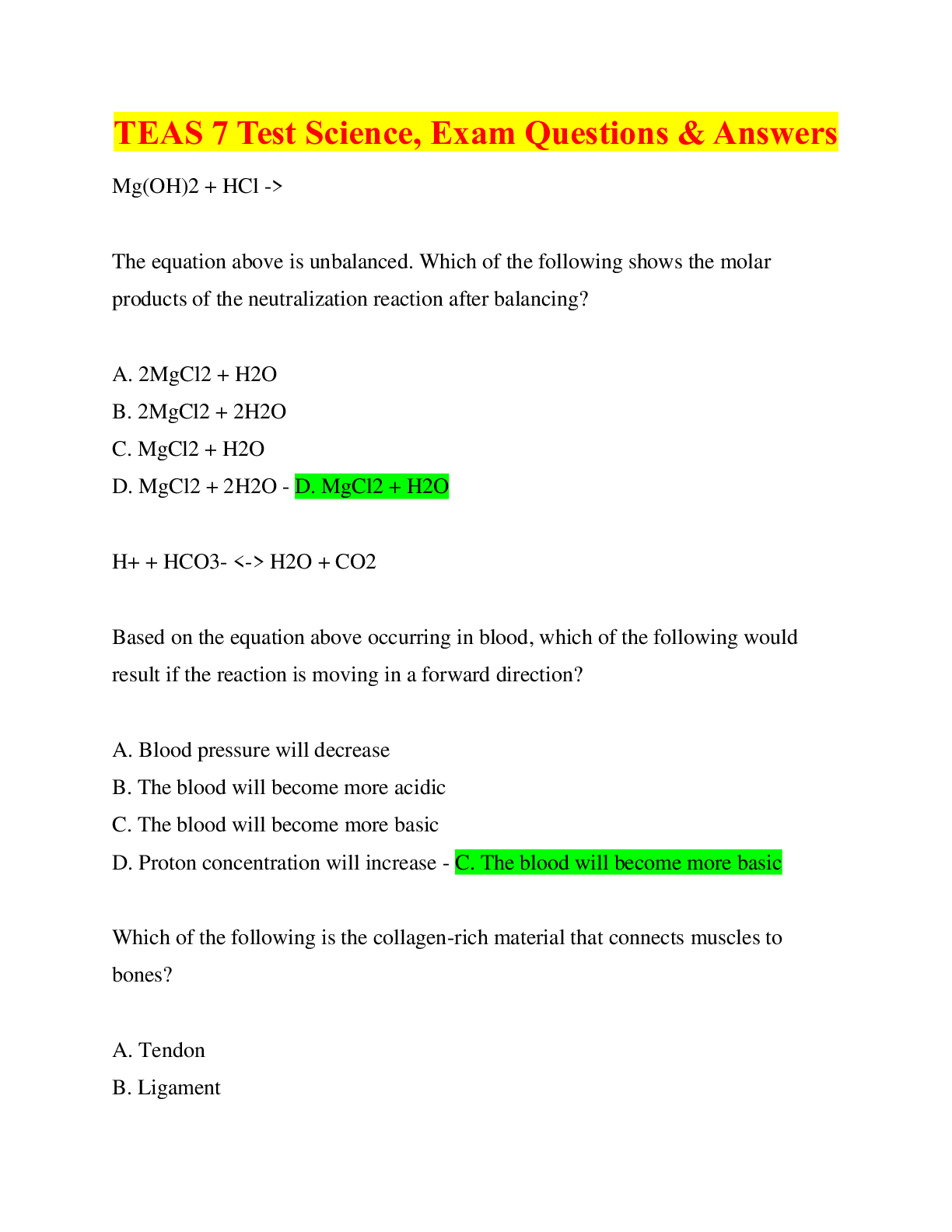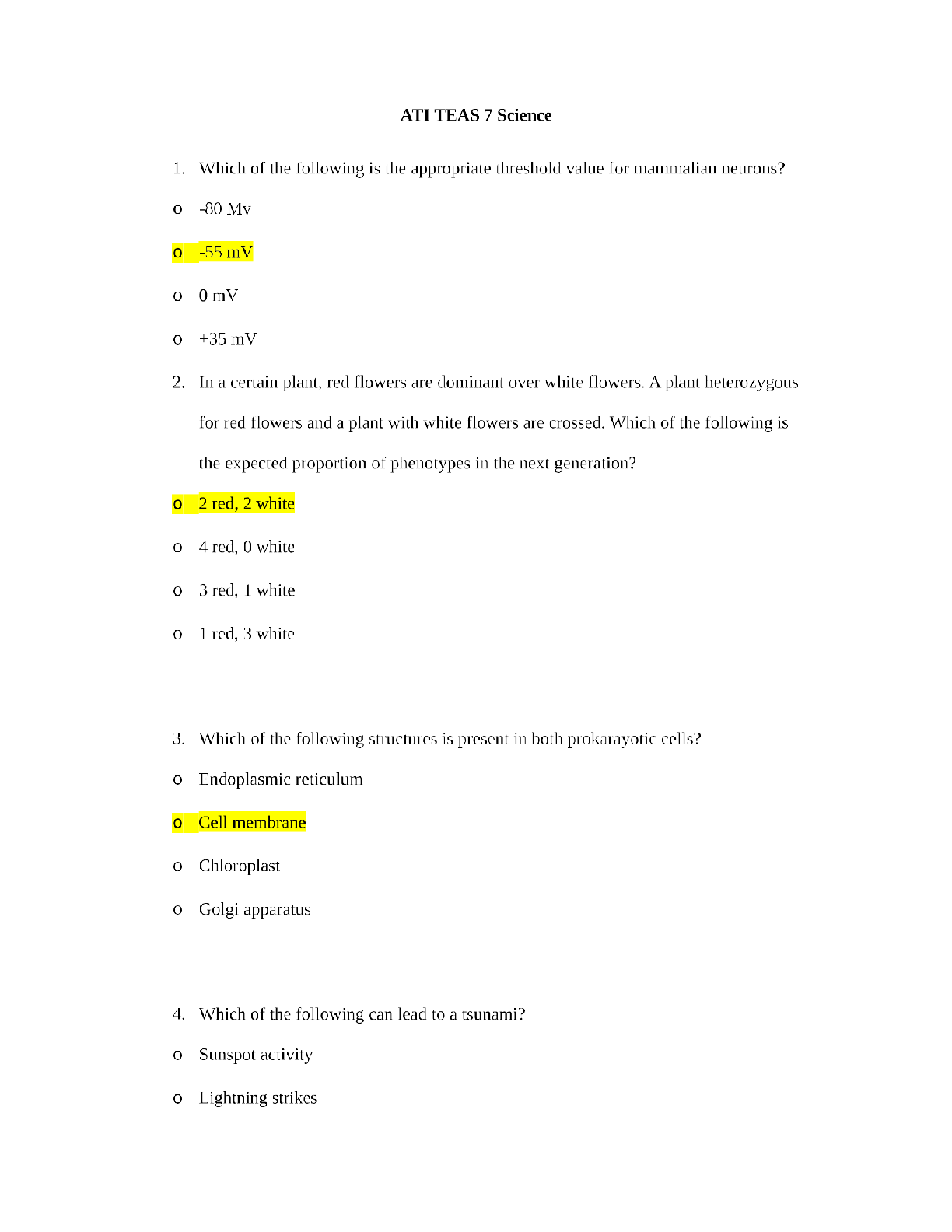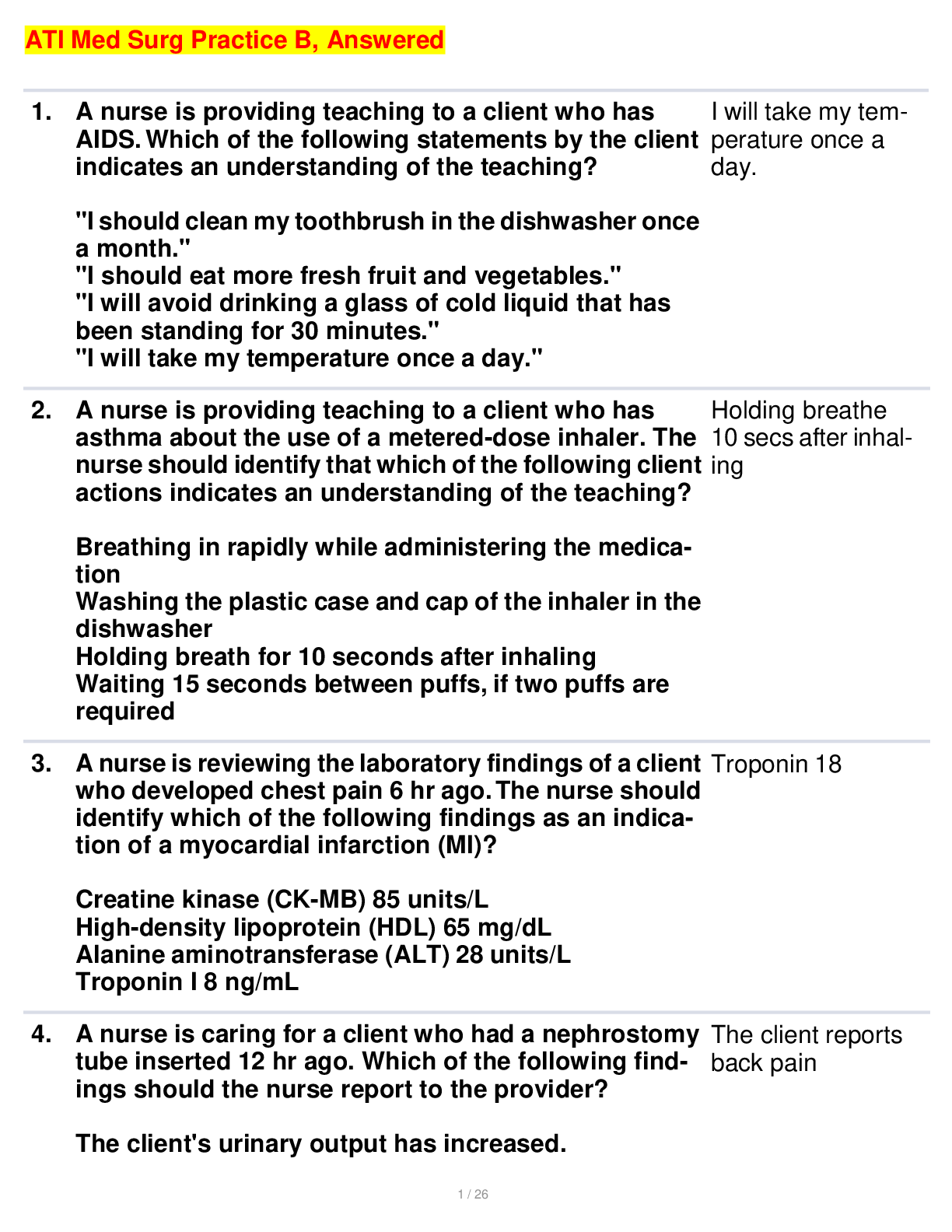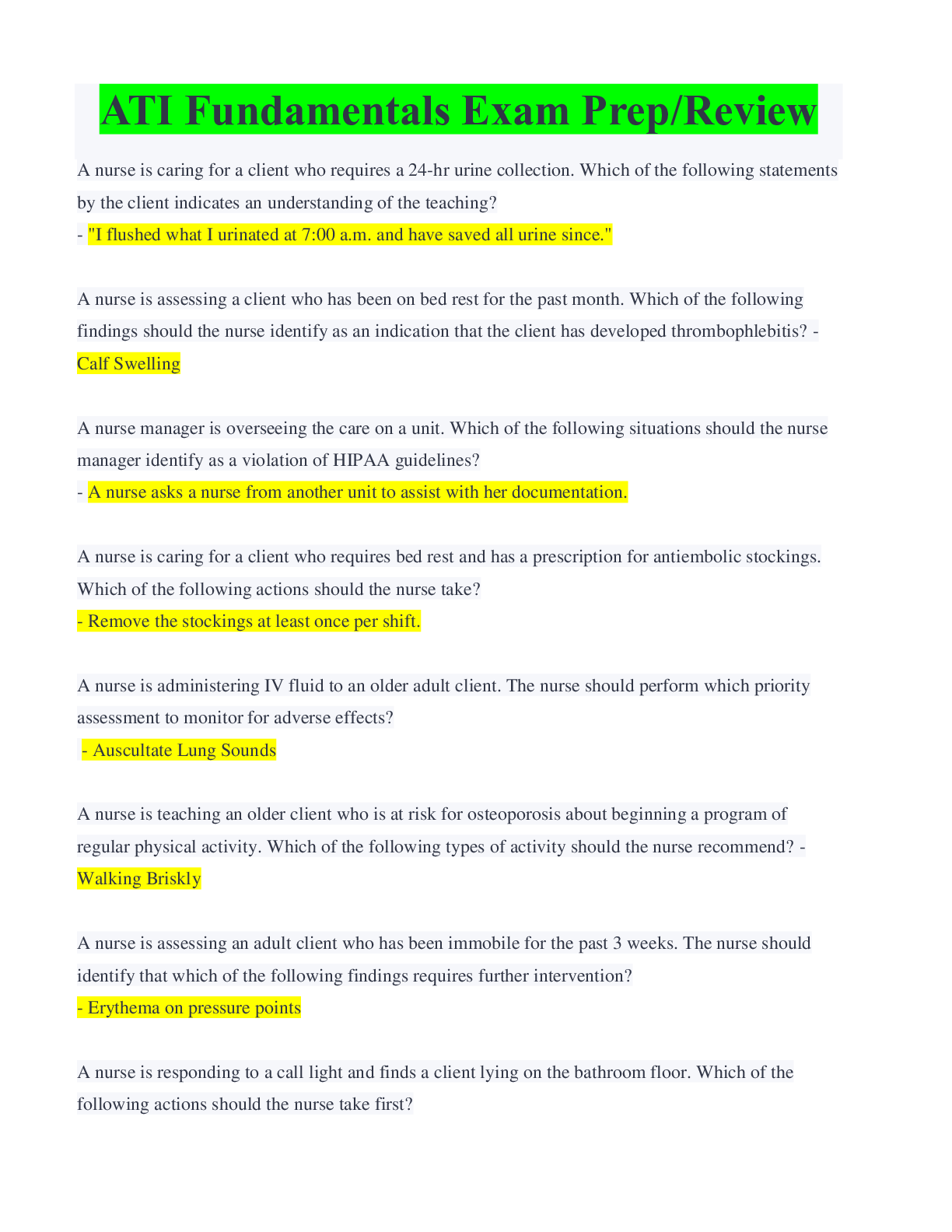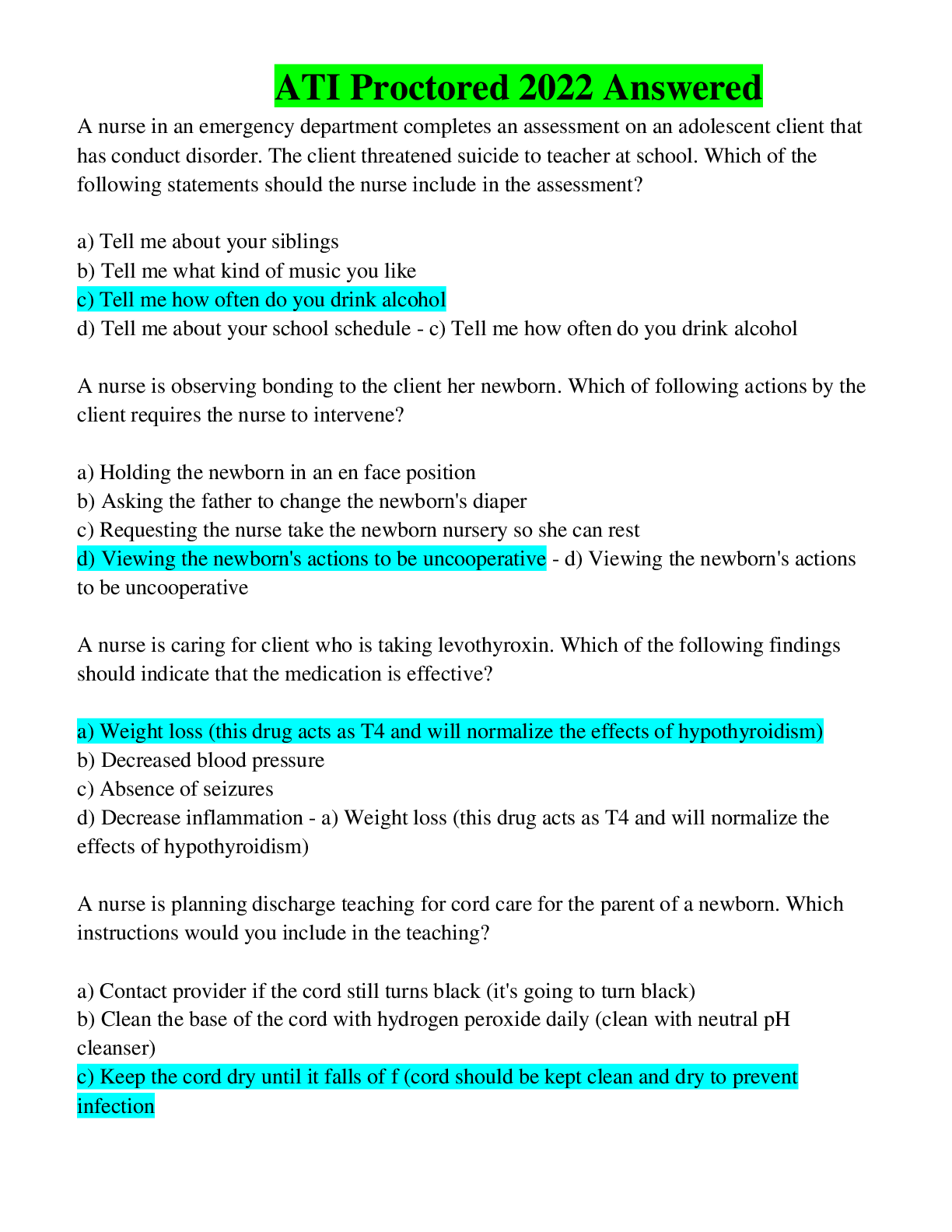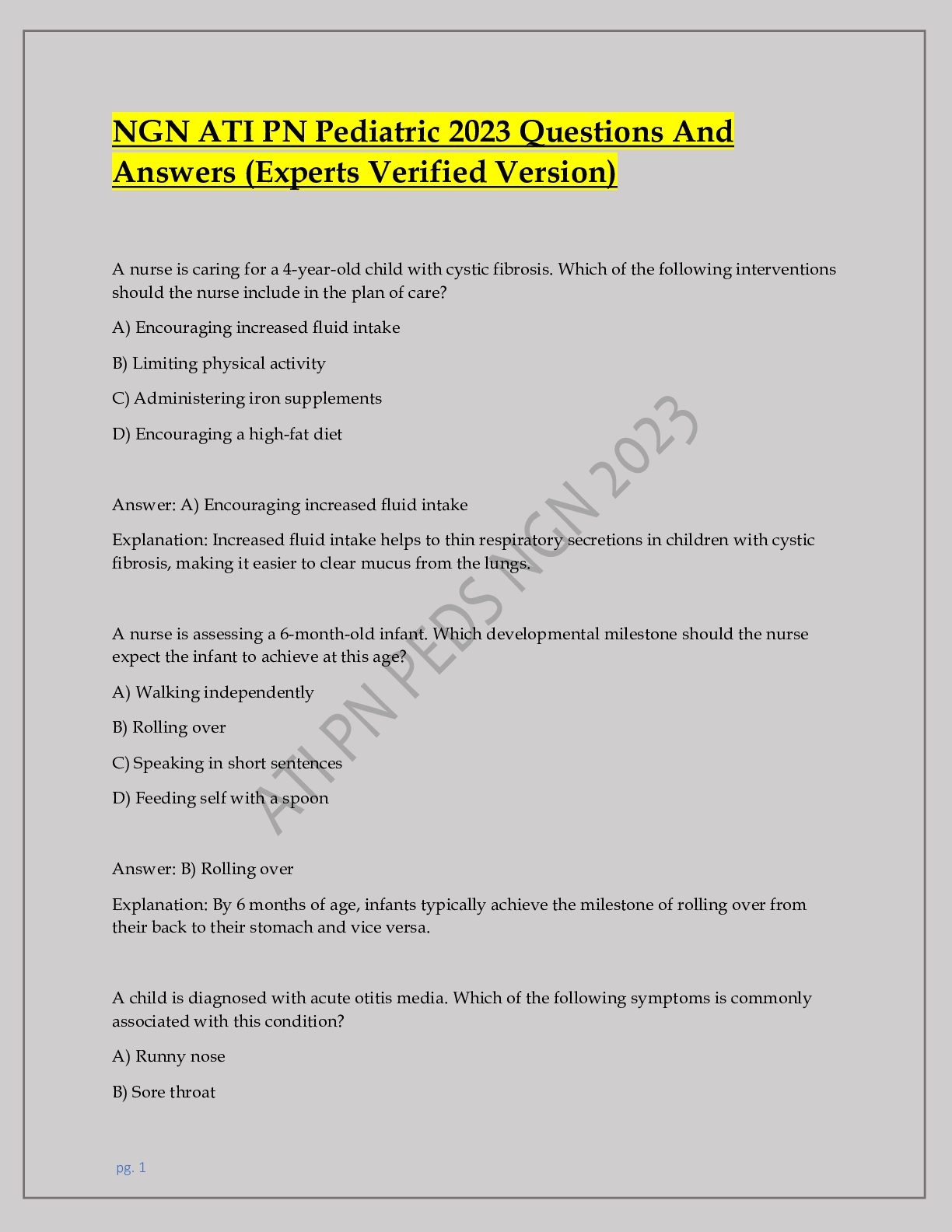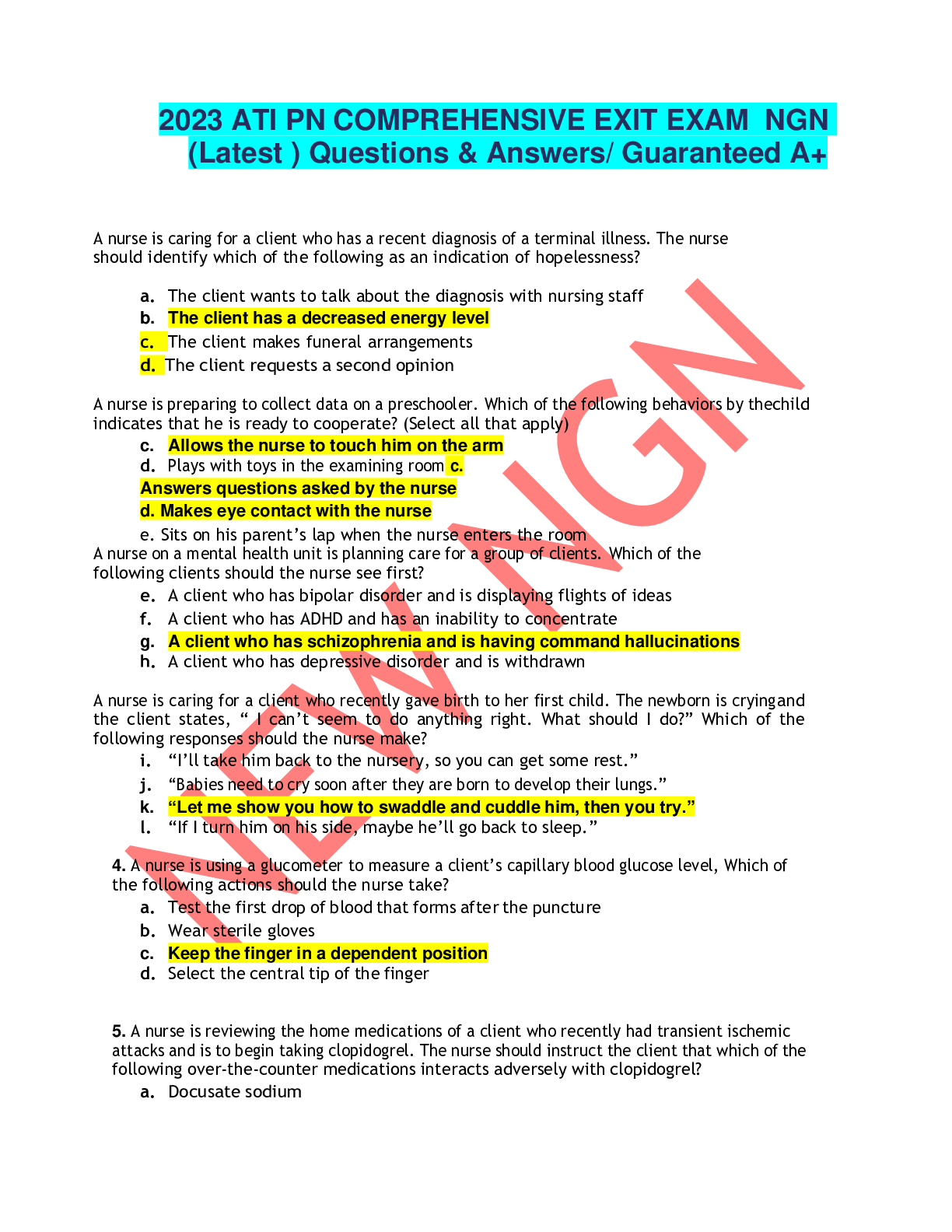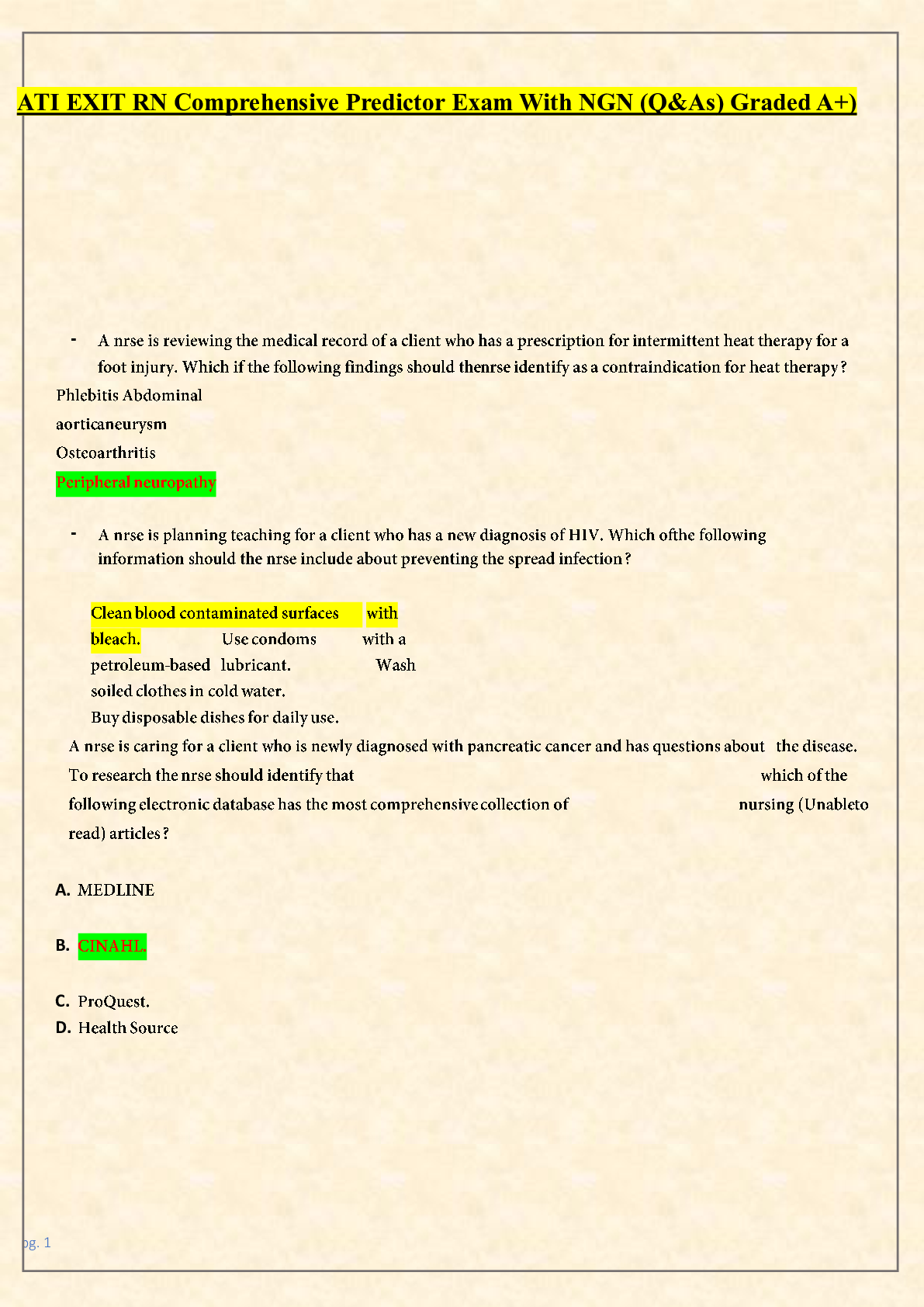Peds ATI 2019 A. All Questions with Explained answers. Graded A.
Document Content and Description Below
Peds ATI 2019 A. All Questions with Explained answers. Graded A. A nurse is caring for a school-age child who is receiving cefazolin via intermittent IV bolus. The child suddenly develops diffuse f... lushing of the skin and angioedema. After discontinuing the medication infusion, which of the following medications should the nurse administer first? - Ans-Epinephrine. This child is most likely experiencing an anaphylactic reaction to the cefazolin. According to evidence-based practice, the nurse should first administer epinephrine to treat the anaphylaxis. Epinephrine is a beta adrenergic agonist that stimulates the heart, causes vasoconstriction of blood vessels in the skin and mucous membranes, and triggers bronchodilation in the lungs. A nurse is teaching the parent of an infant about ways to prevent sudden infant death syndrome (SIDS). Which of the following instructions should the nurse include? - Ans-give the infant a pacifier The nurse should inform the parent that protective factors against SIDS include breastfeeding and the use of a pacifier when the infant is sleeping A nurse is caring for a toddler who has spastic (pyramidal) cerebral palsy. Which of the following findings should the nurse expect? (Select all that apply.) - Ans--Ankle clonus-Exaggerated stretch reflexesContractures. Negative Babinski reflex is incorrect. The nurse should expect a child who has spastic cerebral palsy to exhibit a positive Babinski reflex.Ankle clonus is correct. The nurse should expect a child who has spastic cerebral palsy to exhibit ankle clonus, which is a rhythmic reflex tremor when the foot is dorsiflexed.Exaggerated stretch reflexes is correct. The nurse should expect a child who has spastic cerebral palsy to exhibit spasticity or exaggerated stretch reflexes.Uncontrollable movements of the face is incorrect. The nurse should expect a child who has nonspastic (dyskinetic) cerebral palsy, rather than spastic (pyramidal) cerebral palsy to exhibit uncontrollable movements of the face and extremities.Contractures is correct. The nurse should expect a child who has spastic cerebral palsy to exhibit contractures due to the tightening of the muscles. The nurse is providing discharge teaching to the parent of a child who is 1 week postoperative following a cleft palate repair. For which of the following members of the inter professional team should the nurseinitiate a referral? - Ans-speech therapist The nurse should initiate a referral for a speech therapist for a child who is postoperative following a cleft palate repair. A child who has a cleft palate will require speech therapy immediately following the repair to support speech development and future articulation. A nurse is creating a plan of care for an infant who has an epidural hematoma from a head injury. Which of the following interventions should the nurse include in the plan? - Ans-Implement seizure precautions for the infant.An infant who has an epidural hematoma is at great risk for seizure activity. Therefore, the nurse should implement seizure precautions for the child. A nurse is preparing an adolescent for a lumbar puncture. Which of the following actions should the nurse take? - Ans-apply a topical analgesic cream to the site 1 hr prior to procedure. The nurse should apply a topical analgesic to the lumbar site 1 hr prior to the procedure to decrease the adolescent's pain while the lumbar needle is inserted. A nurse is providing teaching to the parent of a school-age child who has a new prescription for oral nystatin for the treatment of oral candidiasis. Which of the following instructions should the nurse include? - Ans-"Shake the medication prior to administration."The nurse should instruct the parent to shake the medication prior to administration to disperse the medication evenly within the suspension. A nurse in an emergency department is performing a physical assessment on a 2 week-old male newborn. Which of the following findings is the priority for the nurse to report to the provider? - AnsSubsternal retractions. When using the airway, breathing, and circulation approach to client care, the nurse should determine that the priority finding to report to the provider is substernal retractions. This finding indicates the newborn is experiencing increased respiratory effort, which could quickly progress to respiratory failure. A nurse is receiving change-of-shift report on four children. Which of the following children should the nurse see first? - Ans-A school-age child who has sickle cell anemia and reports decreased vision in the left eye.When using the urgent vs. nonurgent approach to client care, the nurse should determine the priority finding is a report of decreased vision in the left eye. This finding indicates that the child isexperiencing a vaso-occlusive crisis and should be reported to the provider immediately. Therefore, the nurse should see this child first. A nurse is assessing a school-age child who has meningitis. Which of the following findings is the priority for the nurse to report to the provider? - Ans-Petechiae on the lower extremitiesThe presence of a petechial or purpuric rash on a child who is ill can indicate the presence of meningococcemia. This type of rash indicates the greatest risk of serious rapid complications from sepsis and should be reported immediately to the provider. A nurse is assessing a 3-year-old toddler at a well-child visit. Which of the following manifestations should the nurse report to the provider? - Ans-Respiratory rate 45/minThe nurse should identify that a respiratory rate of 45/min is above the expected reference range of 20 to 25/min for a 3-year-old toddler and can indicate respiratory dysfunction and acute respiratory distress. Therefore, the nurse should report this finding to the provider. A nurse is reviewing the laboratory report of a school-age child who is experiencing fatigue. Which of the following findings should the nurse recognize as an indication of anemia? - Ans-Hematocrit 28%The nurse should recognize that this hematocrit level is below the expected reference range of 32% to 44% for a school-age child. The child can exhibit fatigue, lightheadedness, tachycardia, dyspnea, and pallor due to the decreased oxygen-carrying capacity. A nurse is planning care for a school-age child who is in the oliguric phase of acute kidney injury (AKI) and has a sodium level of 129 mEq/L. Which of the following interventions should the nurse include in the plan? - Ans-Initiate seizure precautions for the child.A sodium level of 129 mEq/L indicates hyponatremia and places the child at increased risk for neurological deficits and seizure activity. The nurse should complete a neurologic assessment and implement seizure precautions to maintain the child's safety. A nurse is assessing the vital signs of a 10-year-old child following a burn injury. The nurse should identify that which of the following findings in an indication of early septic shock? - Ans-Temperature 39.1° C (102.4° F)The nurse should identify that a temperature of 39.1° C (102.4° F) is above theexpected reference range of 37° to 37.5° C (98.6° to 99.5° F) for a 10-year-old child. The nurse should expect a child who has early septic shock to have a fever and chills. A nurse is caring for an infant who has respiratory syncytial virus (RSV). Which of the following actions should the nurse implement for infection control? - Ans-Have a designated stethoscope in the infant's room.The nurse should initiate droplet precautions for an infant who has RSV because the virus is spread by direct contact with respiratory secretions. Therefore, designated equipment, such as a blood pressure cuff and a stethoscope, should be placed in the infant's room. [Show More]
Last updated: 1 year ago
Preview 1 out of 19 pages
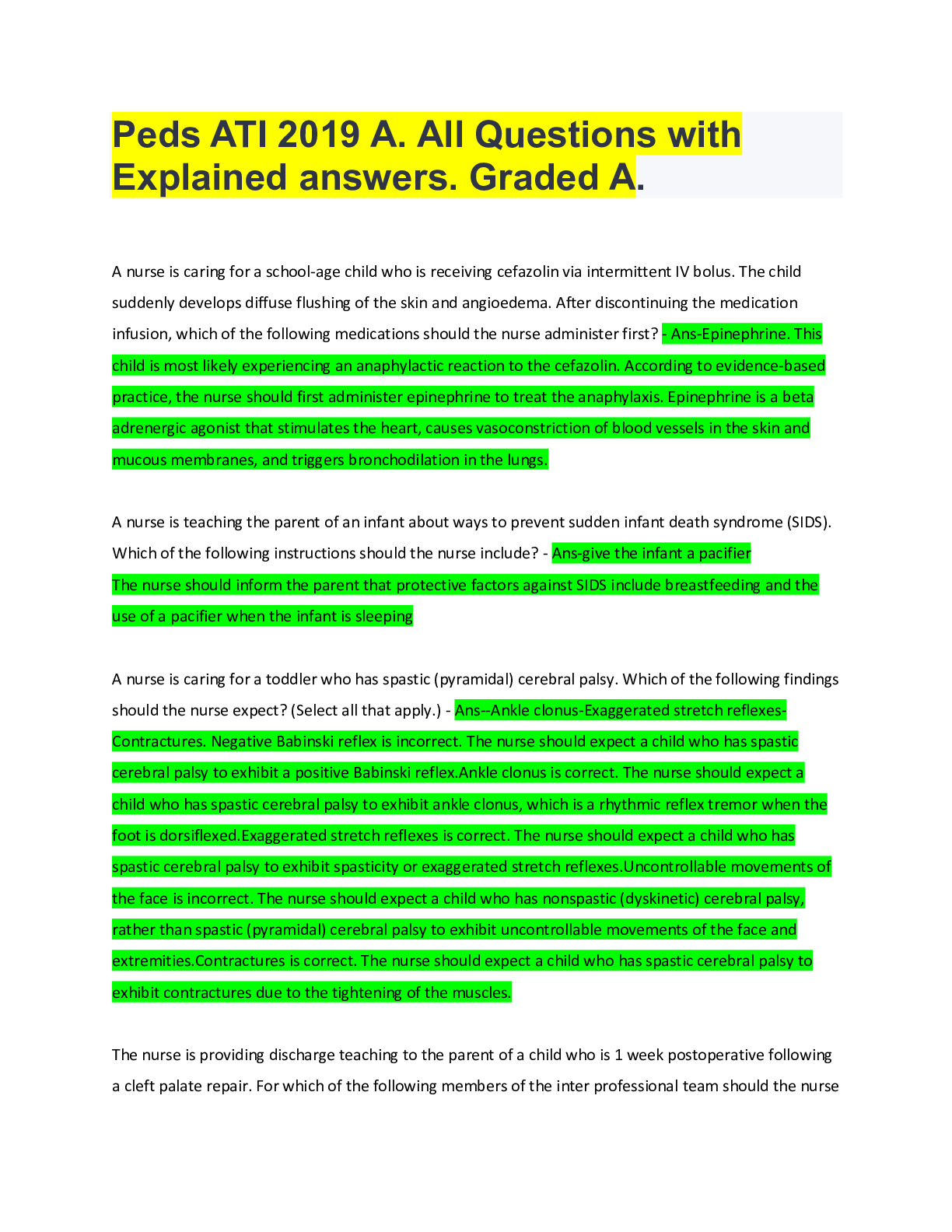
Reviews( 0 )
Document information
Connected school, study & course
About the document
Uploaded On
Jun 29, 2022
Number of pages
19
Written in
Additional information
This document has been written for:
Uploaded
Jun 29, 2022
Downloads
0
Views
58


_Already Graded A.png)
